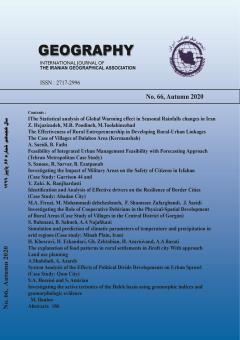Investigating the active tectonics of the Dalek basin using geomorphic indices and geomorphologic evidence
Subject Areas :
1 -
Keywords: Tectonic Geomorphic Indices Basin Dalaki ,
Abstract :
Quantitative measurements allow geomorphologists to compare genuinely and reasonably different landforms and compute morphological indices. This is useful in regionally identifying and describing, for example, tectonic activity. Rivers and drainage networks are one of the most important complications that are very sensitive to tectonic variations. The purpose of this study is to investigate the active tectonics of the Dalaki catchment area using geomorphic indices. In this baseline, six indicators of Bs drainage basin, Hyssometric integral Hi, T transverse T-axis symmetry, I-factor, D-drainage index, and SL-Lagardian length are used. In the study of the relationship between tectonics and morphometry in the studied basin, topographic, geological, topographic maps, geology, meteorology, hydrology, satellite imagery from trustees were prepared and after necessary processing for the research purposes Has been used. The results of the study show that the shape of the semi-arid and semi-symmetrical topographic symmetry is high, but the disturbances in the longitudinal profile of the river are high due to different lithology units and numerous fault structures. According to the survey on accurate data, the displacements that caused the fault are only visible on the Gurpi Formation. In this way, the aggregate data and ground evidence in the aquifer basin is semi-active in terms of the dynamics of the internal forces of the earth.
1. بابائی، شیما، ده بزرگی، مریم، حکیمی آسیابر، سعید، حسینی اصل، امین، (1396)، بررسی زمین ساخت فعال با استفاده از شاخص های ژئومورفولوژی در البرز مرکزی، پژوهش های ژئومورفولوژی کمی، سال ششم، شماره1. ص 56-40.
2. بیاتی خطیبی، مریم، (1388)، تشخيص فعاليت هاي نئوتكتونيكي درحوضه آبريز قرنقوچاي با استفاده از شاخص هاي ژئومورفيك و مورفوتكتونيك، مجله علمي- پژوهشي فضاي جغرافيايي،؛ سال نهم، شماره ي 25
3. بهرامی، شهرام. معتمدی راد، محمد، اکبری، الله، (1392)، بررسي تأثير تكتونيك در ويژگي هاي كمي شبكه زهكشي(مطالعه موردی: چهار حوضه زهکشی در شمال شرق)، مجله مطالعات جغرافیایی مناطق خشک، سال سوم، شماره 12، صص 85- 102
4. رامشت، محمد حسين، سيف ، عبد ا...، شاه زيدي ، سميه و انتظاري، مژگان، ( 1388 )، تاثير تكتونيك جنبا بر مورفولوژي مخروط افكنه درختنگان در منطقه شهداد كرمان، جغرافيا و توسعه ، شماره. 16 ، ص 29 - ص 46
5. روستایی، شهرام، نیری، هادی، (1390)، تحلیل کمی تأثیر لیتولوژی و تکتونیک بر پروفیل طولی رودخانه در حوضه ی آبریز رودخانه مهاباد، مجله جغرافیا و توسعه، شماره 24، صص 153-137.
6. حبیب اللهیان محمود، رامشت محمد حسین،( 1389)، کاربرد شاخص های ارزیابی تکتونیک جنبا در برآورد وضعیت تکتونیکی بخش علیای زاینده رود. مجله جغرافیا و توسعه ، شماره 26. ص 112-99
7. جعفری، غلامحسن، (1394)، بررسی فضایی شاخص های مورفوتکتونیکی دره ها با توجه به ساختمان زمین شناسی(مطالعه موردی: بخشی از ناهمواری های استان زنجان)، مجله هیدروژئومورفولوژی، شماره 5، صص 61-41.
8. جمال آبادی جواد، امیراحمدی ابوالقاسم، مونسیان قاسم، شایان یگانه علی اکبر ، (1393)، بررسی تأثیرات تکتونیکی گسل کمایستان بر شبکه زهکشی و مخروط افکنه ها با استفاده از شاخص های ژئومورفیک در دامنه های شمالی ارتفاعات جغتای، مجله آمایش جغرافیایی فضا فصلنامه علمی پژوهشی دانشگاه گلستان، سال چهارم/ شماره 11
9. عابدینی، موسی، کرمی، فریبا، سرمستی، نادر، (1394)، ارزیابی فعالیت گسل تبریز با شاخص های ژئومورفیک، تکنیک سنجش از دور و GIS، مجله هیدروژئومورفولوژی، شماره 5، صص 40-17.
10. گورابي، ابوالقاسم، نوحه گر، احمد، ( 1386 )، شواهد ژئومورفولوژيكي تكتونيك فعال حوضه آبخيز دركه، پژوهش هاي جغرافيايي، شماره 60 ، ص 178ص
11. منصوری و صفاری (1394)، به تحلیل فعالیت زمین ساختی حوضه آبخیز فرحزاد از طریق شاخص های ژئومورفیک، فصلنامه علمی - پژوهشي اطلاعات جغرافيايي( سپهر)دوره 24، شماره 95
12. کرمی، فریبا، (1391)، ارزیابی نسبی تکتونیک فعال با استفاده از روش های مورفومتری در حوضه های شمالی و شرقی کوه سهند، فصلنامه ی علمی – پژوهشی فضای جغرافیایی، سال دوازدهم، شماره ی 37، صص 18-1.
13. مقصودي، مهران، كامراني دلير، حميد، ( 1387)، ارزيابي نقش تكتونيك فعال در تنظيم كانال رودخانه ها ، مطالعه موردي : رودخانه تجن ، پژوهش هاي جغرافياي طبيعي ، شماره 66 ، ص37 ص 55
14. Argyrioua, Athanasios V, Richard M. Teeuwa, Pantelis Soupiosb, Apostolos Sarris, (2017), Neotectonic control on drainage systems: GIS-based geomorphometric and morphotectonic assessment for Crete, Greece, Journal of Structural Geology, vol 104, p 93-111.
15. Dar, Reyaz Ahmad, Romshoo, Shakil Ahmad, Chandra, Rakesh, Ishtiaq Ahmad, (2014), Tectono-geomorphic study of the Karewa Basin of Kashmir Valley, Journal of Asian Earth Sciences, vol 92, p 143-156.
16. Dehbozorgi, M., Pourkermani, M., Arian, M., Matkan, A.A., Motamedi, H., Hosseinias, H., )2010(. Quantitative analysis of relative tectonic activity in the Sarvestan area, central Zagros, Iran, Geomorphology, Vol. 121, 329–341.
17. Hamdouni, R.E., Irigaray, c., Fernadez, T., Chacon, J., Keller E.A (2008). Assessment of Relative Active Tectonic, South West Border of the Sierra Nevada (Southern Spain), Geomorpholgy, Vol, 96. PP:150-173
18. Keller, E.A., Pinter, N., (1996), “Active, Tectonics: Earthquaqe, Uplift and Landscape, Prentice Hall Publication”, London
19. Keller, E.A., Pinter, N., (2002), “Active Tectonics: Earthquakes, Uplift, and Landscape. Prentice Hall”, New Jersey. 23- Molin
20. Mathew, Manoj Joseph, David Menier, Siddiqui, Numair, Gaurav Kumar, Shashi, Authemayou, Christine, (2016), Active tectonic deformation along rejuvenated faults in tropical Borneo: Inferences obtained from tectono-geomorphic evaluation, Journal geomorphology, vol 267. P 1-15
21. Simoni, A., Elmi, C., Picotti, V., )2003(. Late Quaternary uplift and valley evolution in the Northern Apennines:Lamone catchment, Quaternary International, Vol. 101–102 , 253–267


